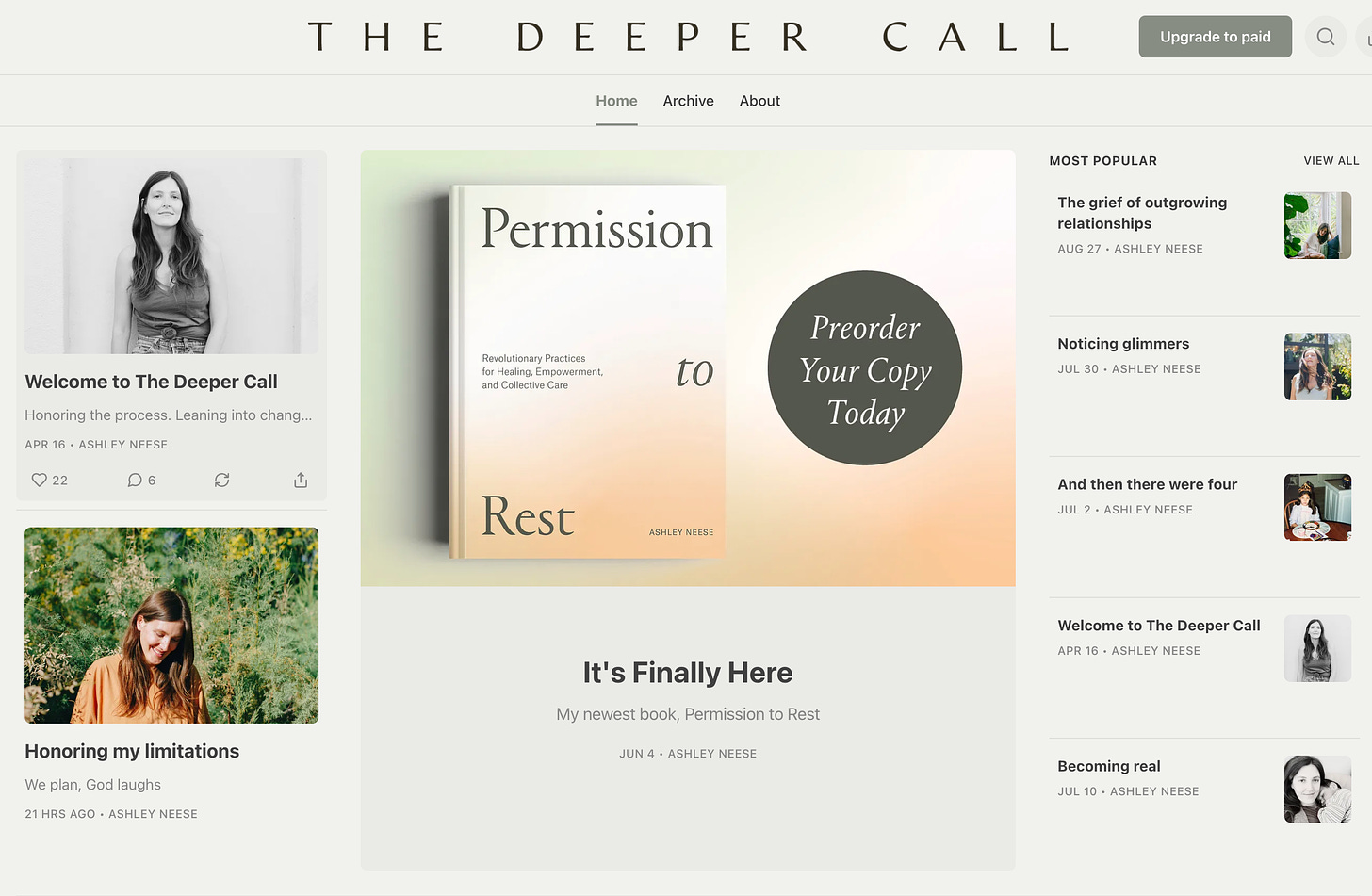Permission to Rest: Substack as a Way to Sustain Ourselves Through Writing
Featured Substack: Ashley Neese's The Deeper Call
Featured Substack: Ashley Neese's The Deeper Call
I love so much about
’s The Deeper Call. It’s visually stunning, causing us to slow down the moment we land on the page. Most importantly, the writing captivates us by its sheer authenticity.Ashley’s life is beyond compelling, yes, but it’s her voice that does it. It’s so genuine that we feel we’re being held, as if by a friend, as we read.
Here’s a taste from her Welcome page:
“As many of you can probably relate, these last few years have been transformational, to say the least. I am not the person I was several years ago…quite frankly, I have trouble recognizing myself most days. My brain isn’t as organized. My desires have shifted. My relationships have evolved (or been released). My clothes don’t fit. My face is softer. My head has some gray hairs now (and I can hear my mother’s voice in my ear, You’ve earned them!). These changes are in part due to mothering now two kids under 4 years old and getting hardly any sleep. They are also in part due to me doing the deeply confronting and often painful work of changing the dynamics in my birth family, moving to the country, healing childhood trauma, facing grief that I have avoided for decades, remembering my inherent connection to the planet, writing another book, and breaking my heart over and over again in this process.”
Ashley is a writer, breathwork teacher, parent, and land steward. Her new book Rest: Revolutionary Practices for Healing, Empowerment, and Collective Care is a masterclass in learning to rest and slow down, something many of us weren’t taught to do in our families of origin.
Highly, highly recommended. I read it in bits and imagine what it would be like to do that thing called rest. :) (Excellent holiday gift idea!)
Ashley’s first book is How To Breathe: 25 Simple Practices for Calm, Joy, and Resilience. She’s been featured in Elle Japan, Sunset Magazine, WJS, goop, Vogue, Well+Good, and W Magazine, among others.
She’s been growing her newsletter for twelve years—that’s twelve, folks—long before Substack, reminding us that having an income-generating newsletter is a long game.
Recently, she’s added a podcast to her Substack with guests like teacher Tracee Stanley and bestselling author and Substack writer
.After reading my interview with Ashley below, subscribe to The Deeper Call, and read one of my favorite posts about the birth of Ashley’s donkey Florence’s new foal.
(Quick note: I did not ask Ashley to mention working with me 1-to-1 in this post—totally unprompted!—but what she says about doing less will be helpful for many to read, so I left it in.)
What’s your Substack about in one sentence?
The Deeper Call is an offering where I use the lens of my life to model curiosity, vulnerability, and living as a practice through my writing.
Who do you write for? Who are your readers?
I share stories and practices for people who want to experience feeling more connection, a deeper sense of belonging, and a longer, slower exhale.
My readers are mostly creative people including authors, meditation teachers, therapists, and artists.
What does The Deeper Call offer them in terms of value?
The Deeper Call offers an embodied perspective from someone who has been practicing, studying, and teaching somatic healing modalities for over twenty years. Here, subscribers will find personal stories, essays, gentle guidance, and emerging research. Subscribers will receive first access to podcast episodes that center conversations around depth, restoration, and connection.
How does The Deeper Call take us to a place no other Substack does?
What I share on The Deeper Call is ultimately connected to the depths I am willing to travel in my own life. Through sharing personal essays and restorative somatic practices, my intention for this Substack is to support subscribers to listen to their own deeper calls.
What advice would you give a writer who's struggling?
Stick with it. I moved over to Substack from Mailchimp and was eager to see growth right away. When it didn’t happen, I was discouraged but kept on publishing each week. I took care with each post to make sure that I was giving the best of what I could offer.
What are some of the ways you’ve strategized on Substack?
I honed in on what specific areas I should focus on with my Substack. I also restructured my About page, offered more consistent ways for my readers to connect with each post, and included Notes in my strategy.
And I now understand that what works on social media doesn’t work on Substack.
What’s the biggest change you’ve made since starting your Substack?
I was starting to feel like I needed to push out content and create all these extras to attract subscribers. I became overwhelmed. I met 1-to-1 with Sarah and she encouraged me to do less. To offer fewer additions and to dive deeper into my writing.
She also encouraged me to embrace why I moved to Substack to begin with: to deepen my writing practice, to connect in meaningful ways with other writers, and to move, however slowly, to sustain more of my life through my writing.








Thanks for sharing Sarah. It reminds me why I moved to Substack too. Not to pump out content, but to become a better writer. One of my teachers, https://substack.com/@professordouglasbrooks, has always said, "You are the company you keep, so keep good company." I am indeed in good company. I also have learned so much already from just one meeting with you, Sarah. Looking forward to the next.
Wonderful!